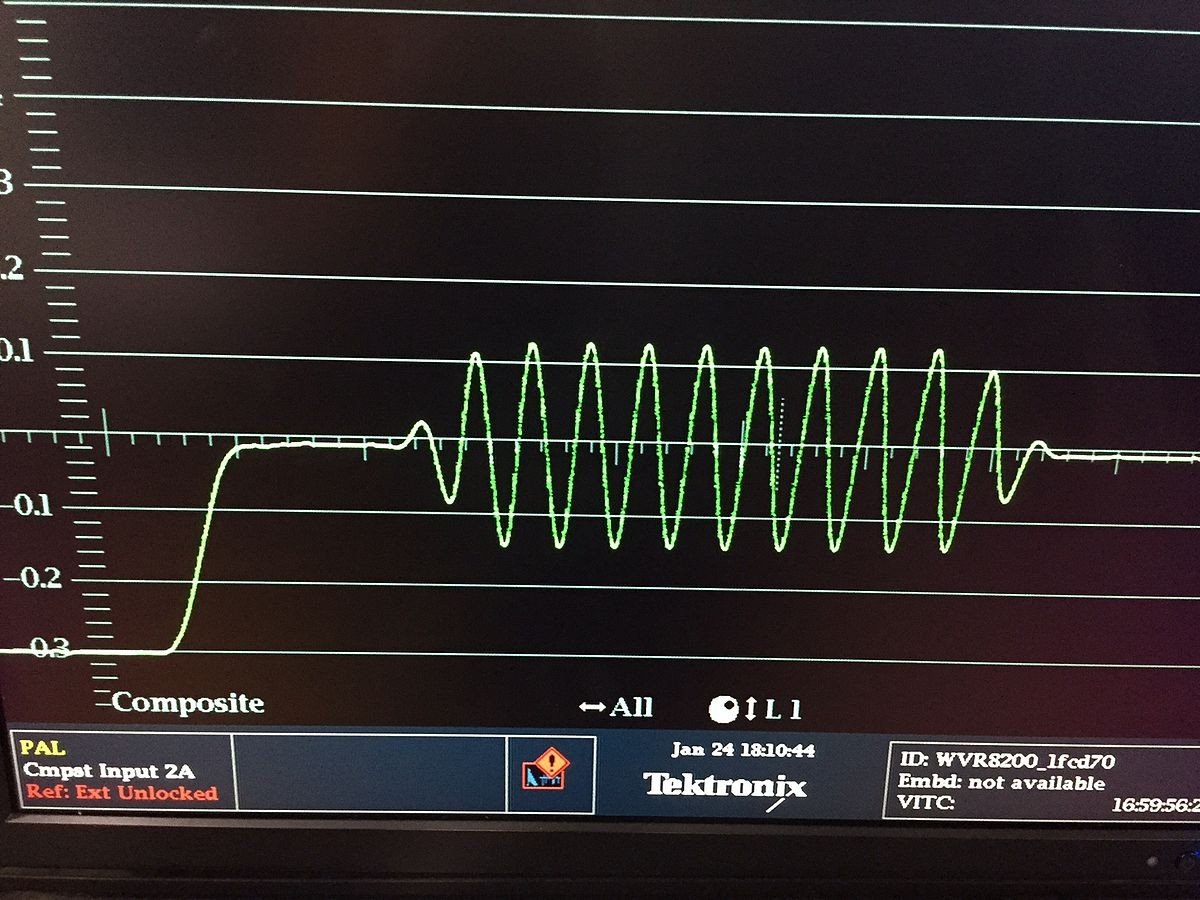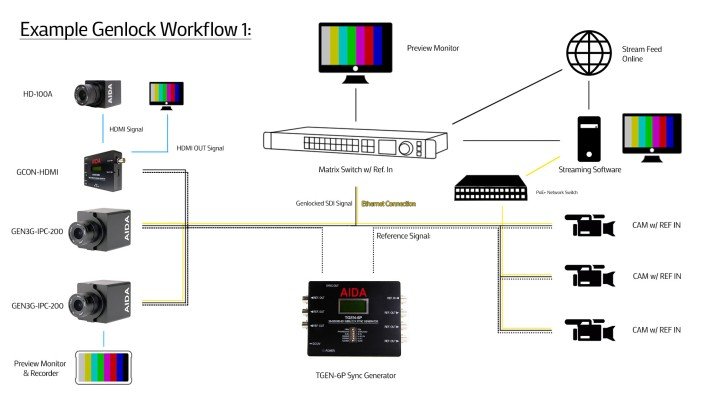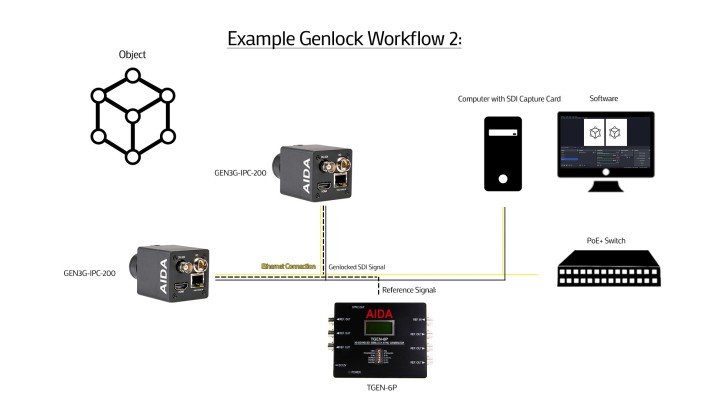Addressing synchronization issues is common when broadcasting multi-camera productions. These issues can become a headache, causing even more stress as showtime approaches without a proper fix. Instead of just hoping for the best when frames don't match up, broadcasters can take advantage of Genlock, which provides practical solutions to mitigate the risk of synchronization discrepancies to ensure a painless setup and seamless viewing experience for your audience.
What is Genlock?
Genlock is a broadcast technique video-capturing devices use to keep your video sources perfectly aligned with consistent output. In the early days of television production, when multiple camera setups were becoming the industry norm, professional broadcasters needed a way to synchronize cameras and video sources. As video systems grew in complexity, so did the need for precise, concurring technology. Genlock is a system that was introduced to address this need by locking video sources to a standard timing signal.
Genlock provides a reference timing signal called a "genlock signal," where all video devices can sync onto a master frame. Genlock serves various essential functions, including vertical, horizontal, frame, and color synchronization, which are all vital for enabling a TV or monitor to display images accurately. In addition to these functions, Genlock also incorporates a fifth feature known as field 1 reference, primarily utilized within the broadcast video industry. Genlocking is now an industry standard used in live sports, concerts, television, and news broadcasts typically transmitted through SDI and BNC connections to provide secure and stable synchronization.
Genlock Signal – Black Burst to Tri-Level Sync
Tri-level sync and Black burst are two types of genlock signals used for synchronizing video productions, differing in their signal structure and usage. Black burst, or composite sync, is a standard-definition signal that includes color burst and sync information. It is still widely used in traditional analog and standard-definition video productions today, where videos are typically below high-definition quality, such as 360p and 480p.
More recently, Tri-level sync has become the modern synchronization approach, designed for high-definition signals at 720p and higher. Unlike Black burst, which uses two voltage levels, Tri-level sync uses three voltage levels, reducing timing jitter to provide finer timing accuracy, an integral function in high-definition video productions. As many workflows transition to higher-quality infrastructures, Tri-level sync is becoming widespread to support modern 1080p productions, offering a more stable and accurate timing reference than Black burst.

Benefits of Genlock in Modern Productions
Genlock reduces the need for extensive post-production synchronization, saving time and resources and allowing broadcasters to focus on creativity rather than technical fixes. It provides a stable and reliable signal distribution in large AV setups to keep all video feeds aligned between multiple screens and video walls. Broadcasters can perfectly align frames, remove image tearing, minimize artifacts and jitters, and provide smoother and more professional video output. Genlocking is effectively non-negotiable now when it comes to events needing synchronized displays. It helps broadcasters create a cohesive visual experience, limiting the need to troubleshoot technical difficulties during production.
Genlock is also helpful for workflows using stereoscopic imaging. Synchronized audio and video capture is crucial for creating captivating 3D effects. When audio and video signals are perfectly aligned, viewers can experience a more realistic and engaging visual production. Studios of any size can use Genlock to create an immersive experience for their audience.
Implementing Genlock Technology
Setting up Genlock is simple with the proper hardware. To use Genlock technology, all cameras and video devices must be Genlock-compatible. Most professional cameras, video switchers, and recording devices should have built-in Genlock support.
A genlock generator provides a reference signal for outputting a timing signal. Start by connecting the generator's Genlock output to the Genlock input for each video device using BNC cables. This way ensures a secure connection to prevent signal loss. Then, set each video device to accept Genlock signals by selecting the appropriate Genlock source and timing parameters. Test the system to ensure all devices are synchronized, and use monitoring tools to verify synchronization and make any necessary adjustments. Different manufacturers may have varying degrees of setup, but this broad overview provides the information required to start your Genlock installation.

AIDA Genlocking Technology
AIDA's GEN3G-IPC-200 camera allows Genlock implementation in any video production workflow. The latest POV camera includes a built-in Genlock reference IN, enabling it to synchronize with any Genlock signal. This hardware and software combination ensures seamless synchronization across all video sources. For optimal performance, it's recommended to use a reference generator with Black burst or Tri-level to send the genlock signal.
AIDA offers the TGEN-6P, a widely-used and reliable tri-level sync generator designed for 1080p full-HD streaming. The TGEN-6P provides a stable reference signal that effectively synchronizes all devices from start to finish. In cases where equipment lacks a native Genlock source, AIDA's GCON-HDMI/SDI converter can convert an HDMI or SDI signal into a Genlocked SDI output, matching any tri-level sync reference input it receives, making it an essential tool in any production's arsenal.

Conclusion
Synchronization is crucial for delivering a professional, hassle-free experience in broadcast and pro AV productions. Whether handling multi-camera setups or creating immersive 3D experiences, it's no wonder why Genlock technology is the industry standard. AIDA offers a range of Genlock solutions, including the GEN3G-IPC-200 camera, TGEN-6P Tri-level sync generator, and GCON-HDMI converter, to help you achieve precise synchronization. You can trust AIDA to elevate your production quality while keeping your content aligned with your goals.
